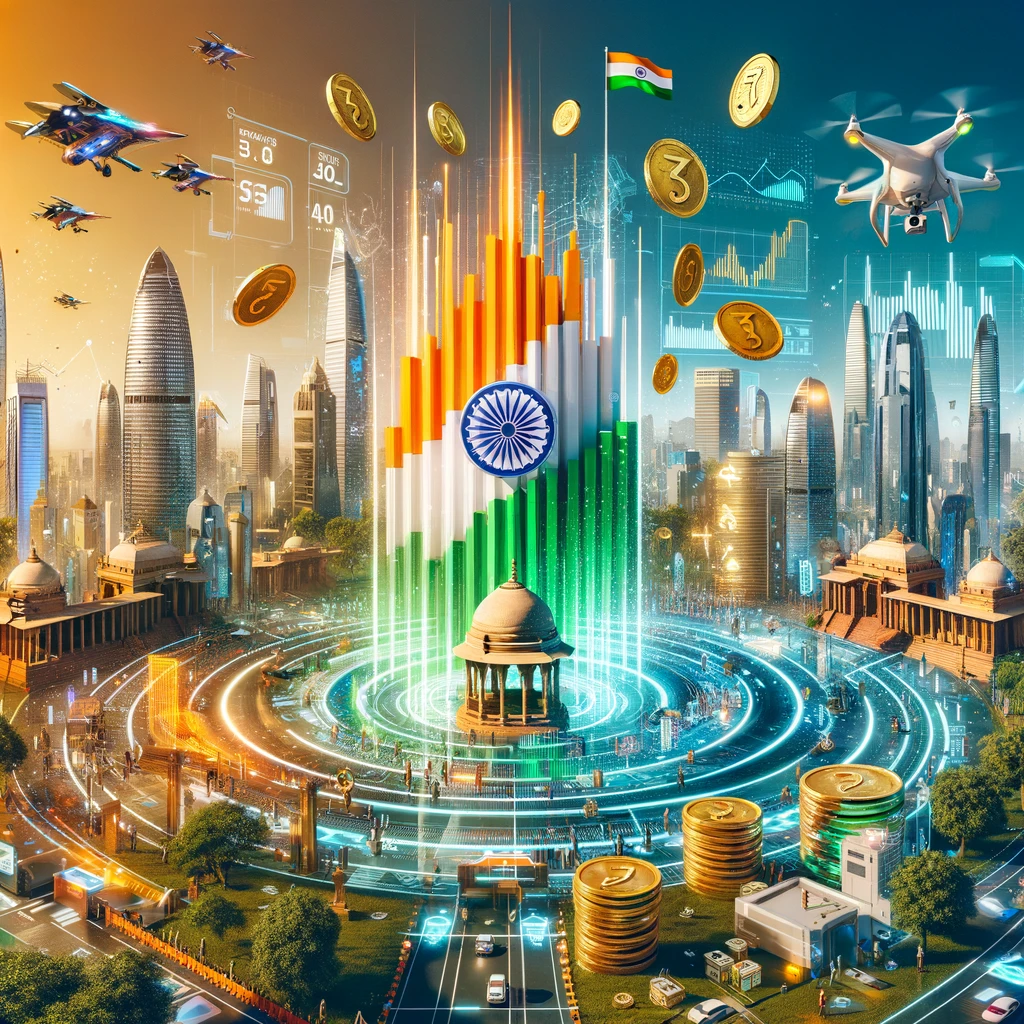Introduction: India’s Economic Growth Unveiled
In 2014, India’s economy was ranked 10th globally. By 2023, it made a monumental leap to become the 5th largest economy, surpassing even the UK. This journey from a $2.84 trillion GDP in 2019-20 to a projected $4.2 trillion by FY24 is not just a testament to India’s resilience but also an outline of its ambitious goal to become a $5 trillion economy by 2024-25. This article explores the strategies, challenges, and global impact of India’s economic ambitions.
The Vision of India – $5 Trillion Economy
India’s Prime Minister announced the goal to double the GDP to $5 trillion, marking a bold step towards comprehensive economic reform and innovation-driven growth. This vision emphasizes not just numerical growth but inclusive development, ensuring benefits across society.
India’s Economic Landscape: A Current Overview
With a current GDP of $3.39 trillion and an expected nominal growth of 10.5%, India’s economy is on an upward trajectory. However, reaching the $5 trillion mark requires maintaining an average growth rate of 9.1% to surpass major economies like Japan and Germany. So far, this is the progress of India in the past 10 years. Below is the improvement in the rankings of India in the world.
| Indicators | 2014 | 2024 |
| Economy Size (GDP) Rank | 10th | 5th |
| Steel Production Rank | 4th | 2nd |
| Mobile Phone Production Rank | 12th | 2nd |
| Number of Unicorns | 4 | 100+ |
| Climate Change Performance Index | 30th | 7th |
| Global Innovation Index | 76th | 40th |
| World Bank’s Logistics Performance Index | 54th | 38th |
| Gender Inequality Index | 127th | 108th |
| Ease of Doing Business | 134th | 63rd |

Growth Drivers: Spearheading India’s Economic Rise
- Digital Revolution: Transformative tech initiatives have remodeled business operations, enhanced efficiency and opening new markets.
- Infrastructure Development: Strategic upgrades in infrastructure are crucial for boosting commerce and overall economic expansion.
- Make in India Initiative: This has significantly increased manufacturing, exports, and job creation, attracting global investors.
- Entrepreneurship and Innovation: Government-backed policies have nurtured a thriving ecosystem for startups and innovation, fueling economic vitality.
Overcoming Challenges: India’s Road to Economic Success
Sustaining growth requires addressing systemic challenges like infrastructure gaps and enhancing skill development, ensuring the economy’s long-term resilience.
Government Policies: Catalysts for Economic Transformation
India has simplified business processes and launched supportive policies for startups and social welfare, increasing the standard of living and attracting foreign investment.
India, a burgeoning economic powerhouse, provides a compelling case study of how strategic governmental interventions can catalyze profound economic transformation. This narrative explores the multifaceted impact of India’s policy reforms on business simplification, startup ecosystem nourishment, social welfare enhancement, and the attraction of foreign investment, ultimately leading to an upliftment in the standard of living.
The inception of India’s economic metamorphosis can be traced back to its initiative to streamline business processes. Recognizing the critical role of an efficient business environment in fostering economic growth, the Indian government embarked on a mission to eliminate bureaucratic red tape, simplify regulatory frameworks, and introduce digital solutions. These reforms have not only facilitated a smoother operation for existing businesses but have also significantly lowered the barriers for new entrants, ensuring a more dynamic and competitive market landscape.
Simultaneously, India’s strategic focus on nurturing its startup ecosystem has been a game-changer. By implementing policies that provide financial incentives, mentorship programs, and ease of access to capital, the government has laid a fertile ground for innovation and entrepreneurship. This vibrant startup culture has not only contributed to job creation but has also been instrumental in addressing some of the country’s most pressing societal challenges through innovative solutions, thus driving social and economic progress.
Moreover, the augmentation of social welfare schemes has been another cornerstone of India’s economic strategy. By bolstering programs aimed at healthcare, education, and social security, the government has endeavored to create a safety net for the most vulnerable sections of society. These initiatives have contributed to improving the overall quality of life, reducing poverty, and ensuring a more equitable distribution of the economic pie. The enhanced standard of living is a testament to the effectiveness of these welfare-oriented policies.
Attracting foreign investment has been another critical aspect of India’s economic policy. Through the liberalization of investment norms, offering tax incentives, and ensuring intellectual property rights protection, India has positioned itself as an attractive destination for international investors. This influx of foreign capital has not only provided the necessary financial resources for its economic endeavors but has also facilitated technology transfer and global best practices, further stimulating economic growth and innovation.
The cumulative impact of these policy measures has been significant, propelling India onto a path of robust economic growth and transformation. The country has witnessed a notable improvement in its standard of living, with increased access to goods, services, and opportunities for a larger segment of its population. Furthermore, the integration of India into the global economy has been accelerated, enhancing its competitiveness on the international stage
Global Standing: India’s Economic Influence
India’s journey toward becoming a major player in the global economy is a fascinating tale of ambition, innovation, and strategic foresight. At the heart of this narrative is a country that has skillfully leveraged its unique assets – a youthful and dynamic population, an entrepreneurial spirit that defies odds, and a government keen on reforming the economic landscape for sustained growth.
Let’s talk about the people of India first. India today is buzzing with the energy of over a billion dreams and aspirations, particularly those of its young population. This vibrant demographic isn’t just a statistic; it’s a force to be reckoned with, driving demand in various sectors such as technology, entertainment, and fashion, and steering the country toward a consumption-led growth model.
The startup scene deserves a chapter of its own. From bustling tech hubs in Bangalore to emerging centers in Tier 2 cities, the country is a hotbed for innovation. Indian startups, with their disruptive ideas, are not only meeting the nuanced needs of the local market but are also scaling globally, attracting billions in investment, and, in turn, spotlighting India on the global economic map.
India’s approach to trade and diplomacy has been equally noteworthy. With a strategic position straddling the East and the West, India is carving out its niche in global trade networks, forging partnerships that extend beyond traditional allies. This proactive stance in international relations is not just about expanding trade but also about asserting its role in shaping the global economic agenda.
The culmination of these factors is an India that stands tall on the global stage, not merely as a market or a destination for outsourcing but as a key influencer of economic trends and a contributor to global innovation. As India continues on this trajectory, its role in the global economy is poised not just to grow but to become integral, offering new paradigms for growth, cooperation, and sustainable development in the 21st century.
Conclusion: Achieving the $5 Trillion Ambition
Strategic planning and inclusive growth are vital for reaching this goal. Investments in education, infrastructure, and technology will be key to sustainable development.
India’s ambition to touch a $5 trillion economy is a story of hope, determination, and collective dreams. It’s not merely about numbers or economic rankings; it’s about weaving a future where every Indian has a shot at success, prosperity, and a better quality of life. This vision is grand, yet deeply personal, touching the lives of millions, from bustling metropolitan cities to the serene countryside.
Imagine the pulse of innovation beating across India, from tech hubs igniting with groundbreaking ideas to startups sprouting in unexpected corners, all driven by the spirit of entrepreneurship. It’s a vision where technology serves not just the few but every corner of the nation, making services and opportunities accessible to all. Digital India isn’t just a government initiative; it’s the heartbeat of the nation’s progress, pushing boundaries and making the impossible, possible.
But what truly fuels this colossal dream? It’s the people. India’s young, spirited, and ambitious population is at the center, ready to learn, innovate, and lead. Education and skill development are key, paving the way for a generation that’s not just job-ready but equipped to tackle global challenges. Think of classrooms buzzing with the energy of curious minds and workshops where hands-on skills are honed — this is where the foundation of a $5 trillion economy is laid.
India’s journey is also about opening its doors wider to the world, inviting investment, ideas, and partnerships. Simplifying business regulations, strengthening trade ties, and ensuring a welcoming environment for entrepreneurs and multinational companies alike are steps toward making India a global economic player.
And amidst this growth story, there’s a green thread woven through — sustainability. India’s commitment to renewable energy, conservation, and eco-friendly practices ensures that this economic leap forward is not at the expense of the planet. It’s about creating a future where growth and sustainability go hand in hand.
In essence, India’s journey to becoming a $5 trillion economy is more than an economic goal; it’s a shared dream that binds every Indian together. It’s about creating a future where prosperity is inclusive, technology is a force for good, and innovation drives progress. The challenges are many, but the resolve of India and its people to turn this dream into reality is stronger. It’s a journey of a billion steps, taken together, toward a brighter, more prosperous future.
